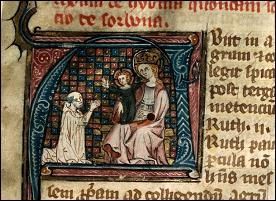The Canadian Society of Medievalists - CSM at ACCUTE 2026
CFP - CSM Sessions at ACCUTE's 2026 conference in Montreal, 4-7 June
Submit your paper proposals on
• Medieval Magic
• Medieval Masculinities
for two CSM-sponsored sessions. Deadline 15 Nov. 2025. Details here www.canadianmedievalists.org/CSM-at-ACCUT...
06.10.2025 18:28 — 👍 3 🔁 2 💬 0 📌 0

At the top: a sculture of a woman with one hand behind her head and the other reaching out, on a grey background. Below that on a gold background are the words, CSANA Virtual Book Launch (for) Bound and Free: Voices of Mortal and Otherworld Women in Medieval Irish Literature by Joanne Findon. With responses from Amy Mulligan (Notre Dame) and Kristen Mills (University of Oslo). Register here (but see registration link in post). Tuesday September 30 12 pm (CST) and 6 PM (BST)
CSM Member Dr. Joanne Findon's new book, Bound and Free: Voices of Mortal and Otherworld Women in Medieval Irish Literature, is being celebrated with a virtual book launch on September 30! All are welcome but registration is required here: uark.zoom.us/meeting/regi.... See the poster attached.
11.09.2025 12:42 — 👍 1 🔁 0 💬 0 📌 0
Tudor tournaments were thus, Emma-Catherine argues "deeply rooted in Early English tournaments," not Burgundian models.
16.07.2025 13:51 — 👍 0 🔁 0 💬 0 📌 0
Emma-Catherine Wilson discussed early Tudor Tournament letters arguing that rather than relying on Burgundian models as other scholars have suggested, the Tudors drew from "a long lineage of insular tradition" in issuing challenges and creating the literary pageantry of tournaments.
16.07.2025 13:51 — 👍 0 🔁 0 💬 1 📌 0
Her work has traced the life of this textile fragment from an Islamic courtly setting in Grenada to a Christian Church in Castile. The fabric was eventually cut and survives now in fragments across the world. In its fragmented form these textiles served as book and treasure wraps.
16.07.2025 13:51 — 👍 0 🔁 0 💬 1 📌 0
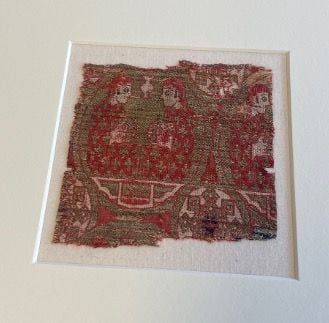
Next up was Iris Bednarski who shared her work on a textile fragment now housed at the McGill Museum of Fine Arts. The pic here was kindly provided by Iris. The project attempted "to reconstruct the life of [this] object". The fragment is probably from Grenada and was likely created in the 13th c.
16.07.2025 13:51 — 👍 0 🔁 0 💬 1 📌 0
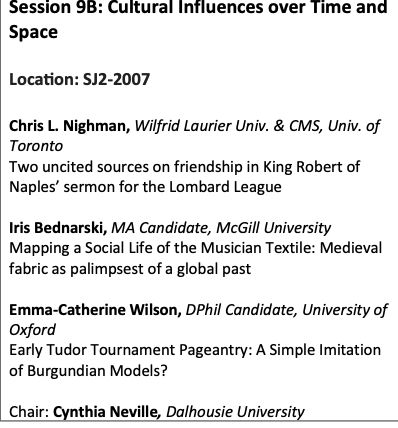
Another excellent panel from this year's CSM Annual Meeting. Chris Nighman spoke about two previously unknown sources for Robert of Naple's Sermo factus pro liga Lombardie, the Manipulus florum and John of Wales' Communiloquium. Much of Dr. Nighman's recent work has been exploring the manuscripts
16.07.2025 13:50 — 👍 1 🔁 0 💬 1 📌 0
nothing has survived to the present day. Dr. Bacola also noted the importance of the Fenland in the area, allowing for isolated conditions for those (saints) seeking solitude. Using ArcGIS also brings to light local power dynamics between neighbouring monasteries.
10.07.2025 12:14 — 👍 0 🔁 0 💬 0 📌 0
Finally Meredith Bacola described how she is using ArcGIS as a tool for understanding the development of Crowland Abbey. Amongst other fascinating findings, using ArcGIS made it clear that the geography supported the information found in hagiographies of St. Guthlac (and important finding since
10.07.2025 12:14 — 👍 0 🔁 0 💬 1 📌 0
was being read, but in the libraries, not the infirmaries, he speculates. @winstonblack is on bluesky, so ask questions!
10.07.2025 12:14 — 👍 1 🔁 0 💬 1 📌 0
kept in the infirmary not the library, and shows clear evidence of the incorporation of the textual knowledge in the MS into medical practice. Dr. Black also hinted that there was a distinction to be made between textual medicine and the medicine of the infirmaries. Constantine Africanus' new work
10.07.2025 12:14 — 👍 1 🔁 0 💬 1 📌 0
Next Winston Black reminded us that we should not be ignoring the role of monasteries in the history of medicine. Perhaps the locus of that medical knowledge was not only found in the libraries and scriptoria but in the infirmaries. Dr. Black's work on Bethesda NLM E8 suggests that manuscript was
10.07.2025 12:14 — 👍 1 🔁 0 💬 1 📌 1
a monastic community, Hildegard's own monasteries suggest her attitude may have been more flexible on this than her writing suggests. There is some evidence that suggests the presence of conversae in or near Rupertsberg. As always, Gudiño warns categories for class and types of religious are porous.
10.07.2025 12:14 — 👍 0 🔁 0 💬 1 📌 0
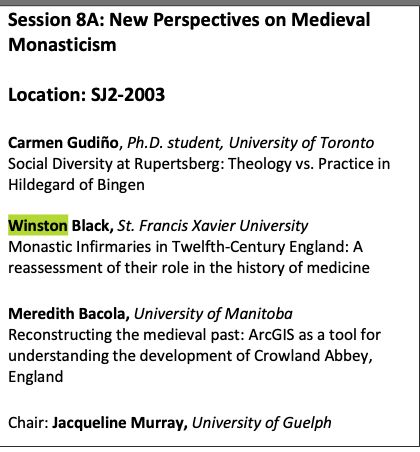
A list of papers presented in a panel. The text is as follows:
Session 8A: New Perspectives on Medieval
Monasticism
Location: SJ2-2003
Carmen Gudiño, Ph.D. student, University of Toronto
Social Diversity at Rupertsberg: Theology vs. Practice in
Hildegard of Bingen
Winston Black,
St. Francis Xavier University
Monastic Infirmaries in Twelfth-Century England: A
reassessment of their role in the history of medicine
Meredith Bacola,
University of Manitoba
Reconstructing the medieval past: ArcGIS as a tool for
understanding the development of Crowland Abbey,
England
Chair: Jacqueline Murray,
University of Guelph
Another day, another panel. First up, Carmen Gudiño, who examined the class diversity at the monastery of Rypertsberg under Hildegard of Bingen. While Hildegard's writings suggest that the importance of hierarchy when responding to a colleague's idea that only nobles should be allowed to enter into
10.07.2025 12:14 — 👍 1 🔁 0 💬 1 📌 0
Unfortunately, the paper by Dr. Laumonier on Montpelier butchers and their neighbours and environs had to be cancelled. We look forward to hearing about this project at future CSM Annual Conferences.
07.07.2025 18:13 — 👍 0 🔁 0 💬 0 📌 0

A recent photograph of Pont Neuf with the Île de la Cité in between the two different sections.
the consequences of such events much more visible. Attached here is a modern image of Pont Neuf, (credit: Wiki Commons) which is now the oldest bridge in in Paris, opened in 1607, long after the Great Winter.
07.07.2025 18:13 — 👍 0 🔁 0 💬 1 📌 0
This resulted in the Left Bank being isolated from the Île de la Cité or beyond. These parts of Paris became only accessible by ferry making trade and travel from the Left Bank much more difficult. Dr. Hutchison's larger point was how mapping some of the events found in chronicles can make
07.07.2025 18:13 — 👍 0 🔁 0 💬 1 📌 0
the importance of locating people in space as well as time for historians. Next up, CSM's treasurer, Emily Hutchison, who explored some of the impacts of the onset of the Little Ice Age on Paris. One example: when the Seine broke up after the "Great Winter" of 1408, it took down three bridges.
07.07.2025 18:13 — 👍 0 🔁 0 💬 1 📌 0
Amongst her interesting findings, that jongleurs lived near butchers and tanners, near Jongleur street, but perhaps not ON it, interacted with Jewish populations, and lived near taverns and places that would have allowed for good busking. It was fascinating and important research, that demonstrates
07.07.2025 18:13 — 👍 0 🔁 0 💬 1 📌 0
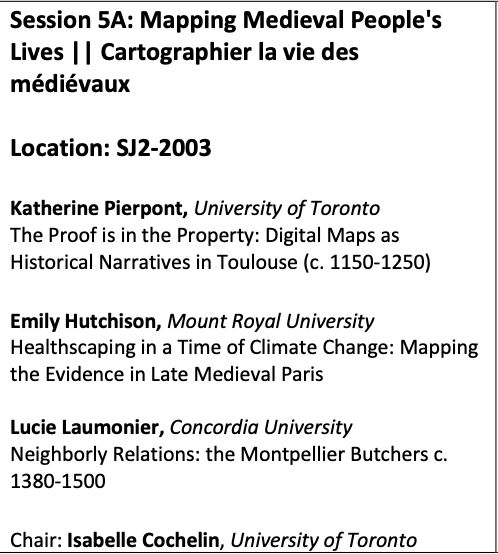
A part of a conference schedule noting the names of scholars and titles of papers for a particular panel, details below.
Session 5A: Mapping Medieval People's
Lives || Cartographier la vie des
médiévaux
Location: SJ2-2003
Katherine Pierpont, University of Toronto
The Proof is in the Property: Digital Maps as
Historical Narratives in Toulouse (c. 1150-1250)
Emily Hutchison, Mount Royal University
Healthscaping in a Time of Climate Change: Mapping
the Evidence in Late Medieval Paris
Lucie Laumonier, Concordia University
Neighborly Relations: the Montpellier Butchers c.
1380-1500
Chair: Isabelle Cochelin, University of Toronto
Another day, another session summary! To begin, Katherine Pierpont used municipal records to trace the presence of troubadours and jongleurs in medieval Toulouse. Her work enables her to sometimes place individuals in precise domiciles and allows her to start to understand their social networks.
07.07.2025 18:13 — 👍 0 🔁 1 💬 1 📌 0
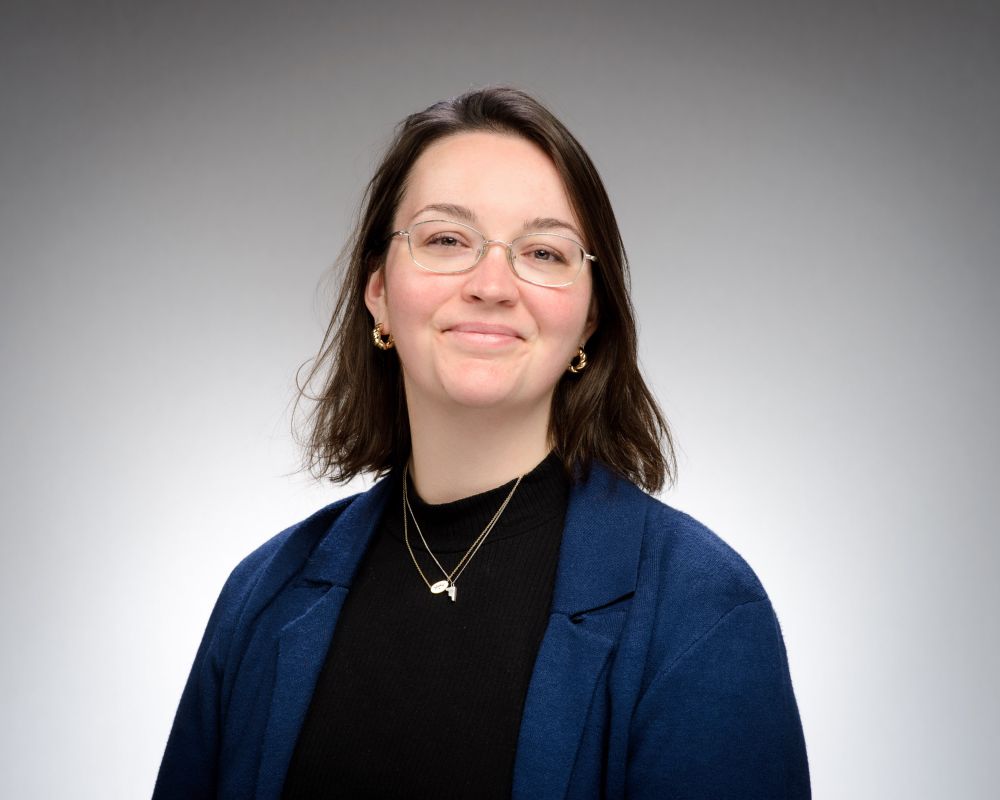
Laura Moncion
Congratulations to Laura Moncion, 2025 winner of the @canmedievalists.bsky.social Leonard Boyle Dissertation Prize! 🎉
www.medieval.utoronto.ca/news/laura-m...
04.07.2025 17:08 — 👍 8 🔁 1 💬 0 📌 0
Beowulf himself remains unchanged, and able to feel nothing at all -- a luxury not afforded to the grieving mother.
03.07.2025 14:14 — 👍 0 🔁 0 💬 0 📌 0
the framing of her character in previous translations and discussions as monstrous. This creates moments/ a continual experience of dysphoria in the reader. But further, change is forced on Grendel's mother--she is forced to repent the act of her grieving (and the destruction that followed) while
03.07.2025 14:14 — 👍 0 🔁 0 💬 1 📌 0
the agency Silence has in crafting their gender. Finally Gavin Foster explored Headley's representation of Grendel's mother as defined by her grief in her translation of Beowulf. Foster notes that although Headley asserts Grendel's mother acts out of grief and as a warrior, she cannot escape
03.07.2025 14:14 — 👍 0 🔁 0 💬 1 📌 0
continued and continuing transformation and the suggestion that traditional categories can be straddled, or perhaps better, entirely :"liquified". Adrien Savard-Arsenault explored trans characters in Roman de Silence and Yde et Olive noting the seemingly stricter system of gender in Yde et Olive and
03.07.2025 14:14 — 👍 0 🔁 0 💬 1 📌 0
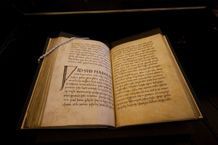
An image of a folio page from the Exeter Book.
and heredity. Jes Battis invited us to imagiine Old English poetry as containing passages of trans joy and resistance Pointing to Wulf and Eadwacer and The Phoenix in particular. While content was explored, so was OE grammar and the idea of a kenning, both of which, Battis suggested, allow for
03.07.2025 14:14 — 👍 4 🔁 0 💬 1 📌 0
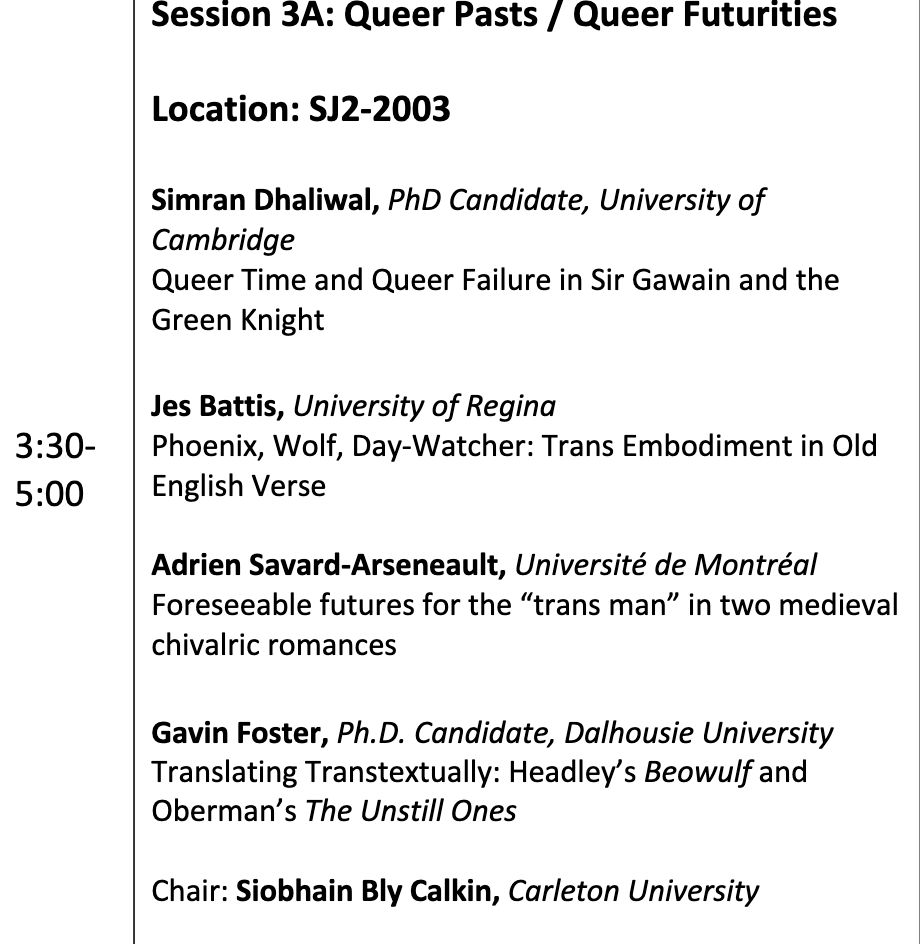
An imge of a conference program that take place between 3::30 adn 5:30. The panel is entitled Session 3A: Queer Past/Queer Futurities and includes the following papers:
Location: SJ2-2003
Simran Dhaliwal, PhD Candidate, University of Cambridge
Queer Time and Queer Failure in Sir Gawain and the Green Knight
Jes Battis, University of Regina
Phoenix, Wolf, Day-Watcher: Trans Embodiment in Old English Verse
Adrien Savard-Arseneault, Université de Montréal
Foreseeable futures for the “trans man” in two medieval chivalric romances
Gavin Foster, Ph.D. Candidate, Dalhousie University
Translating Transtextually: Headley’s Beowulf and Oberman’s The Unstill Ones
Chair:
Siobhain Bly Calkin, Carleton University
Next up, a terrific panel entitled Queer Pasts and Queer Futurities. All of these papers looked at queer spaces, times and identities in medieval texts. Simran Dhaliwal discusses the fragility of a happy, carefree child-like Arthur in the court of Camelot in the face of expectations of masculinity
03.07.2025 14:14 — 👍 1 🔁 0 💬 1 📌 0
Create and share social media content anywhere, consistently.
Built with 💙 by a global, remote team.
⬇️ Learn more about Buffer & Bluesky
https://buffer.com/bluesky
Research project @Oslo/Uppsala/Reykjavík/Copenhagen
Examining viking warriorhood and its representations past and present
Project info: https://www.khm.uio.no/english/research/projects/making-a-warrior
Concordia’s Premier History Graduate Conference ✨ Coming April 2025
Celebrating 30 Years 📣
Concordia University, Tiohtià:ke/Montreal
https://hitmconcordia.wixsite.com/hitm
Dean of the Krieger School of Arts and Sciences at Johns Hopkins University, author of *The Italian Renaissance and the Origins of the Modern Humanities*
Medievalist. Teaching writing, medieval literature, and gender. she/her
www.Lecouteur.ca revue en ligne de critiques musicales et d’articles sur la musique depuis 2015.
Permanently tired PhD candidate at St Andrews / Medievalist and Art Historian / Cathedrals, patronage, archiepiscopacy, liturgy / she/they
Association francophone de médiévistique. Canada, France, Suisse, Belgique : #histoire, #litterature, #philosophie, #philologie #médiévales.
Organisation du 🏆 #PrixAlmadesJeunesChercheur.euses
➡️ https://www.alma-recherche.com
Centre for Medieval English Studies at @sorbonneuniversite.bsky.social
Jesteśmy kompanią Słowian i Wikingów z Katowic i okolic 🐺
Odtwarzamy rejon morza Bałtyckiego z IX-XI wieku.
Zajmujemy się wojaczką i rzemiosłem ⚔️
Dołącz do nas już dziś!
wilczakompania.pl
Adjunct prof, PhD in Historical Archaeology ✨️
Mortuary Archaeologist & Museum Educator. I like graves, the C17th, landscapes, & protective magic. I preserve gravestones, write books, & paint pictures (she/her)
https://linktr.ee/RLacy
A behind-the-scenes perspective on the Nova Scotia Museum’s Archaeology Collection – news, curious artifacts, and more.
Bioarchaeologist 💀
Animal and travel lover 🌍 🐶
Current project: the #Bioarchaeology of communal health: infectious diseases, medical care, and funerary practices in #medieval and early modern northern Italy (BioComm)
Former MSCA
Sapienza University of Rome
Litríocht na Gaeilge, Léann na hÉireann, early modern Irish (as in Gaelic) literature, activism, LGBTQIA, teaching Irish to the Fighting Irish, feminism...founder-member of the soon-to-be-dissolved Department of Irish Language and Literature, Notre Dame
Curieux, particulièrement intéressé par tout ce qui a trait aux sciences humaines, surtout l'Histoire et sa composante médiévistique. J'éprouve également de l'appétence pour l'actualité et les relations internationales.
Medievalist, PhD'ing at Cambridge. Chaucer, gender, trauma. Bringing the voices of medieval women forward.
Shakespeare + Early Modern English Lit. Manuscripts. Book History. Bibliography. DH. Canada Research Chair in Digital Humanities & English Professor at StFX University
Frágiles relámpagos. I mostly repost interesting things. Books, languages, science and philosophy.
🗣️ 🇺🇸🇲🇽🇧🇷 🧗🇷🇺🇯🇵



